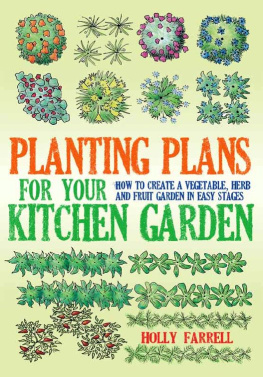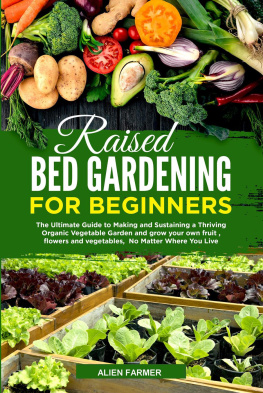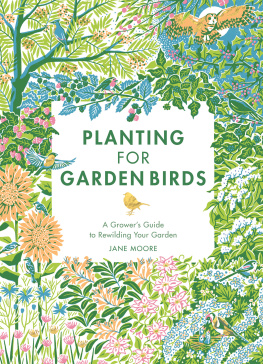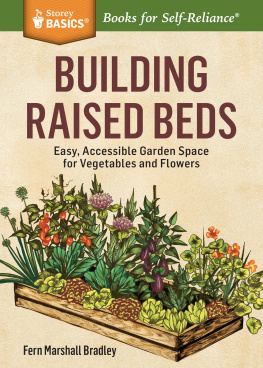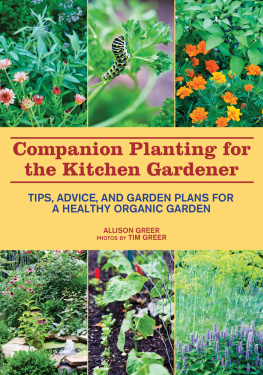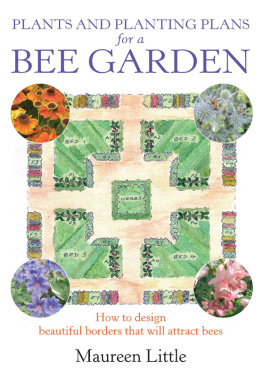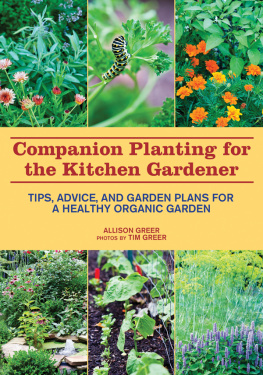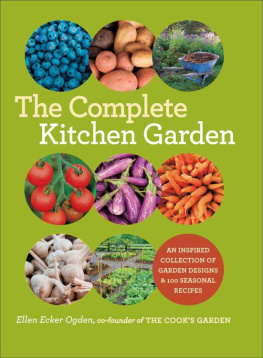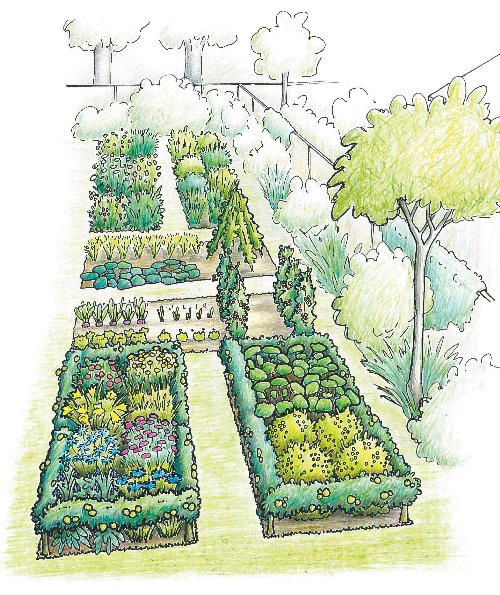
Planting Plans
For Your
Kitchen Garden
Contents

Other books by Spring Hill, an imprint of How To Books:
HOW TO GROW YOUR OWN FRUIT AND VEG
A week - by - week guide to wild - life friendly fruit and vegetable gardening
JOE HASHMAN
THE BEE GARDEN
How to create or adapt a garden to attract and nurture bees
MAUREEN LITTLE
PLANTS AND PLANTING PLANS FOR A BEE GARDEN
How to design beautiful borders that will attract bees
MAUREEN LITTLE
THE BEE KEEPERS FIELD GUIDE
A pocket guide to the health and care of bees
DAVID CRAMP
Write or phone for a catalogue to:
How To Books
Spring Hill House
Spring hill Road
Begbroke
Oxford
OX5 1RX
Tel . 01865 375794
Or email:
Vist our website www.howtobooks.co.uk to find out more about us and our books.
Like our Facebook page
How To Books
Follow us on Twitter
@Howtobooksltd
Read our books online www.howto.co.uk
To Kevin
Published by Spring Hill, an imprint of How To Books Ltd.
Spring Hill House, Spring Hill Road, Begbroke, Oxford OX5 1RX United Kingdom
Tel: (01865) 375794 Fax: (01865) 379162
www.howtobooks.co.uk
First published 2013
All rights reserved. No part of this work may be reproduced or stored in an information retrieval system (other than for purposes of review) without the express permission of the publisher in writing.
Text 2013 Holly Farrell
British Library Cataloguing in Publication DataA catalogue record of this book is available from the British Library.
ISBN: 9781908974020
Produced for How To Books by Deer Park Productions, Tavistock, Devon
Designed and typeset by Mousemat Design Ltd
Printed and bound by Graficas Cems, Villatuerta, Spain
E-Book production by www.mousematdesign.com
eISBN 9781908974259
NOTE: The material contained in this book is set out in good faith for general guidance and no liability can be accepted for loss or expense incurred as a result of relying in particular circumstances on statements made in the book. Laws and regulations are complex and liable to change, and readers should check the current position with relevant authorities before making personal arrangements.
This book is not intended as a medicinal reference book, but as a source of information. The reader is advised not to attempt self-treatment using any herbal remedies without consulting a qualified medicinal herbalist. Neither the author nor the publisher can be held responsible for any adverse reactions to the recipes, recommendations and instructions contained herein, and the use of any herb or derivative is entirely at the readers own risk.
Planting Plans
For Your
Kitchen Garden
Contents
PREFACE
When I started gardening, I was frustrated by the fact that all the books had endless detail about the different varieties of fruit and veg I could grow, and endless lists of all the things that could go wrong with that fruit and veg, but very little on how to go about laying out my plot. I was also wanting to grow lots of different things, not just the staples: cut flowers, edible flowers and herbs too, and few books included all of these things. Id been inspired by the kitchen gardens of the great country estates, and wanted to recreate their functional beauty, on a small scale, on my allotment. Now Ive trained with the Royal Horticultural Society, and been gardening for many years, Ive written the book I wanted to read and use when I started out.
Of course I wouldnt have got this book to print without the help, support and encouragement of many people along the way. Chief among them is my husband Kevin, who tolerated the trials of living with a first-time author with patience and a smile. I am incredibly grateful to him for this and so much more. Huge thanks are also due to Sue Moss for all her sterling work on the illustrations, and Mum for her encouragement and proof-reading. Thanks also to Richard Farrell for tech support and web design, and to Marcia Peacock for horticultural advice. Finally, thanks to Nikki Read and Giles Lewis for taking a chance on an unknown.
INTRODUCTION
All you need to get started growing your own food and cut flowers is here: combine the planting plans in this book to turn your garden or allotment into a beautiful and productive space. Other kitchen gardening books leave it up to you to decide what to grow where. If you havent the time or the confidence to worry about that, then this book is for you. You can create your own modular kitchen garden step by step, like a piece of modular furniture.
The chapters take you through the process of creating your kitchen garden a step at a time. First, assess your space and decide what you want to grow. Then dig the beds for your modules, and follow the instructions for sowing seeds and planting. The module plans show how to lay out each one. Finally, maintain your modules with the advice on basic garden tasks in the General Maintenance chapter. A glossary covers all the terms that may not be familiar.
Planting Plans for your Kitchen Garden is intended for beginners of any age and with any type of garden. There are more than 35 planting plans for vegetables, fruit, herbs and cut flowers, and plants to attract wildlife. Whether you want to grow easy summer salads or Brussels sprouts for Christmas, there is a plan you canuse.
Chapter 1
HOW TO USE THIS BOOK
There are two main sections: the modules, and the how to bits, which contain all the general advice on growing vegetables, fruit, herbs and cut flowers.
The first step is planning assessing your site and deciding what you want to grow. Then choose your modules. Chapter 3 has plans showing possible combinations of modules for different situations, such as a garden to provide vegetables through the seasons, or a garden supplying fruit, edible flowers and flavourings for the home baker.
Once you have dug your beds and are ready to plant, use the planting plans for each module youve chosen to guide you in planting up the bed, following both the general advice in Chapter 4 and the specific advice for that module.
Each module plan is at a scale of 1:10, i.e. 1 centimetre (cm) on the plan represents 10cm on the ground. All the modules are 1 metre (m) by 2m. Use the plans to determine how far apart to space your plants. Each plant on the plans is drawn with a black dot in its centre this is the point at which you should plant it. Not all the plants can be shown on some plans, so check the table in the module detail for how many plants are needed.
The potential yields of the fruit and vegetable modules are given. These are the average harvests you can expect without major (pest or disease) problems from each module in a growing season. The average potential yields for the fruit modules are of mature plants dont expect as much in the first couple of years.
Chapter 11 has all the advice on how to maintain your modules through the year. However, you wont find off-putting long lists and gruesome pictures of all the things that could go wrong. To sort a particular problem, see the section for sources of advice.
Next page
